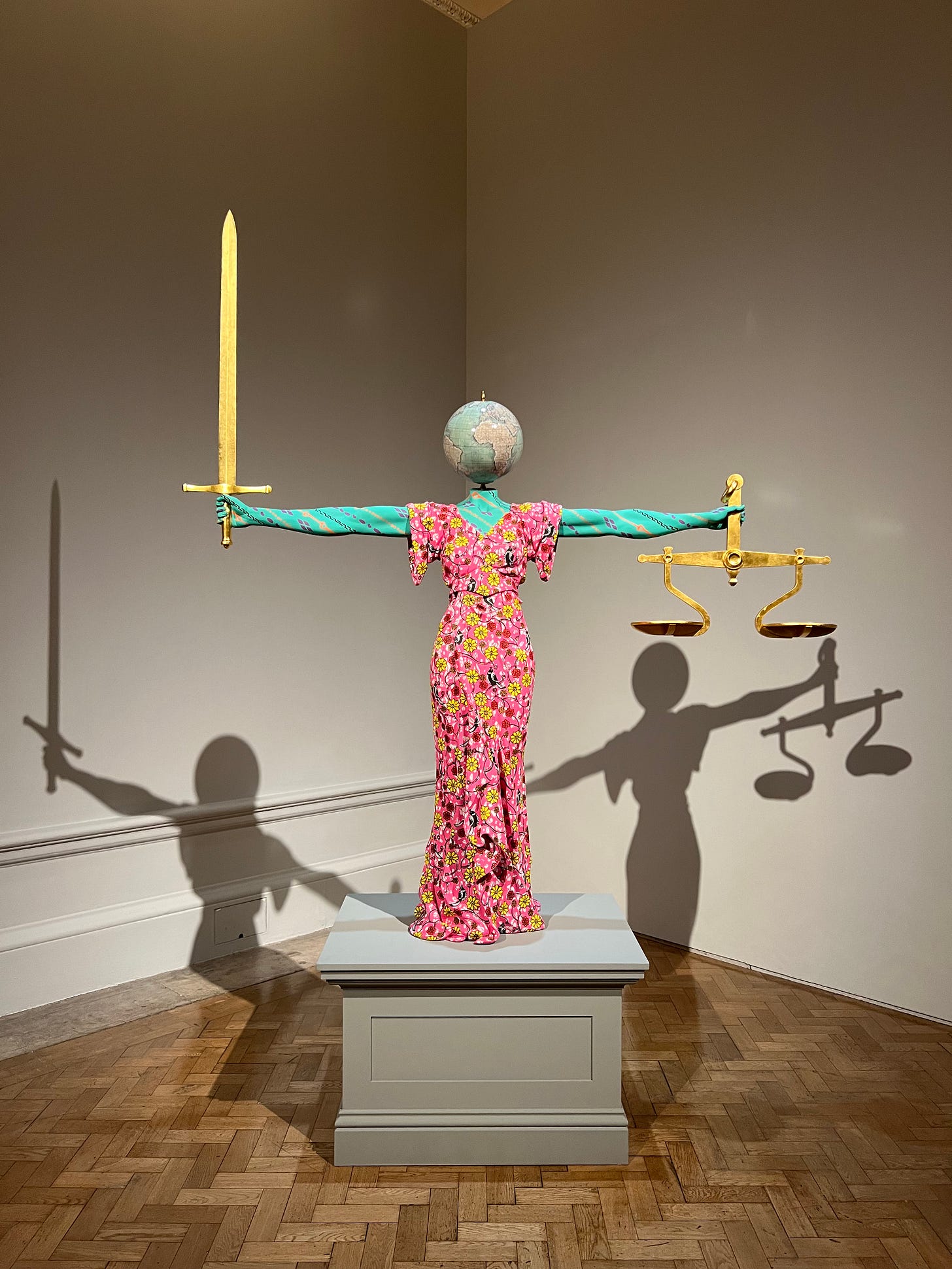On a recent trip to London, I had the chance to see “Suspended States,” an exhibition by Yinka Shonibare CBE, an internationally acclaimed British artist of Nigerian heritage, at the Serpentine Gallery. Working in a range of mediums, including drawing, painting, sculpture, photography, and film, Shonibare’s work explores themes of authenticity, identity and colonialism. If you’re wondering, as I was, the “CBE” at the end of his name stands for “Commander of the Order of the British Empire,” a title he was awarded in 2019.
One of the pieces that resonated with me was “The War Library,” an installation of 5,000 books individually bound in Dutch wax print representing global conflicts and peace treaties. The walls were lined with floor-to-ceiling white bookshelves filled with clothbound books. The spines were embossed with the names of civil wars, rebellions, revolts, and massacres from all over the world, alongside documents of peace and protection. As I studied the shelves, I reflected on our current moment, and felt their physical and emotional weight.
Growing up, my family had a set of encyclopedias in our den, the black and gold spines of the Encyclopedia Britannica striping the shelves in stately columns. As a child, I thought those tomes held all the knowledge in the world. I didn’t question who had curated the contents, or consider what had been left out.
Shonibare’s library asks the viewer to consider both the human appetite for violence and destruction, and our continued efforts to repair the damage. Would we ever break the cycle? Despite the heavy subject matter, the visual delight of the fabric wrapping left me elated and oddly hopeful.
“The point of ‘The War Library’ is actually…to expose our amnesia, to show that we always repeat the same thing over and over again. And also the importance of the archive. The importance of memory.” (Shonibare)
The library as a conceptual space is a continued theme in the artist’s oeuvre. In 2014, he showed “The British Library'' at the Tate Gallery, which highlighted first and second generation immigrants who made significant contributions to British culture and society. In 2018, he showed “The African Library,” at Goodman Gallery in Capetown, South Africa, consisting of six thousand books wrapped in Dutch wax print fabric and embossed with the names of the personalities who shaped the formation of Africa in the post colonial period. Currently at the Skirball Center in Los Angeles, California, Shonibare has installed “The American Library,” featuring six thousand books wrapped in textiles with the names of US immigrants and Black Americans affected by the Great Migration.
Dutch wax-print fabric, also known as Ankara or African wax print, is a hallmark of Shonibare’s work. These boldly patterned, brightly colored fabrics have become a symbol of African culture and a touchstone for the African diaspora. Yet they are actually an import with a complex history dating back to the early 1800s.
The story begins in the Dutch East Indies in 1811, where British colonial officer, Sir Thomas Stafford Raffles, was studying the art of Indonesian batik. The traditional process was both time-consuming and labor intensive. Trained artisans applied melted wax in intricate designs onto cotton cloth; the cloth was then over-dyed, more hot-wax designs were applied, and the cloth was dyed again. Raffles intended to mechanize the process and create a cheaper version to resell to the Indonesian market.
By 1846, Dutch manufacturer Vlisco had perfected the imitation batik using roller printing. But the commercially produced cloth was not well received in Indonesia. Dutch wax print eventually found a home in West African colonies. By the 1940s and 50s, businesswomen in Togo monopolized the import of Dutch wax print fabric, becoming the link between European manufacturers and the local community. These women were dubbed Nana Benz, a term that combined their social standing as matriarchs, and the wealth they were able to accumulate. From symbols of marital conflict to commemorative Nelson Mandela prints, local women shaped the narratives embedded in the vibrant designs.
“I always thought that the fabrics were authentically African, but then I realized the fabric has a complex history…The fabrics, for me, have now become a symbol of the myths that we construct for ourselves.” (Shonibare)
This iconic and heavily imitated cloth is actually a symbol of globalization hiding in plain sight. Shonibare evokes but also reclaims this legacy. While one could argue that these motifs become repetitive, the artist is continually exploring new ways to integrate the patterning, as shown throughout “Suspended States.” As a viewer new to the work, Dutch wax print serves as a distinct vernacular connecting his decades-long career.
In interviews, Shonibare speaks often about expressing both beauty and darkness in his work. For me, “The War Library” succeeded in evoking both the painful and the sublime.
Shonibare’s exhibition, “Suspended States” is on view at the Serpentine Gallery until September 1st.
A few more photos of the artist’s work…








